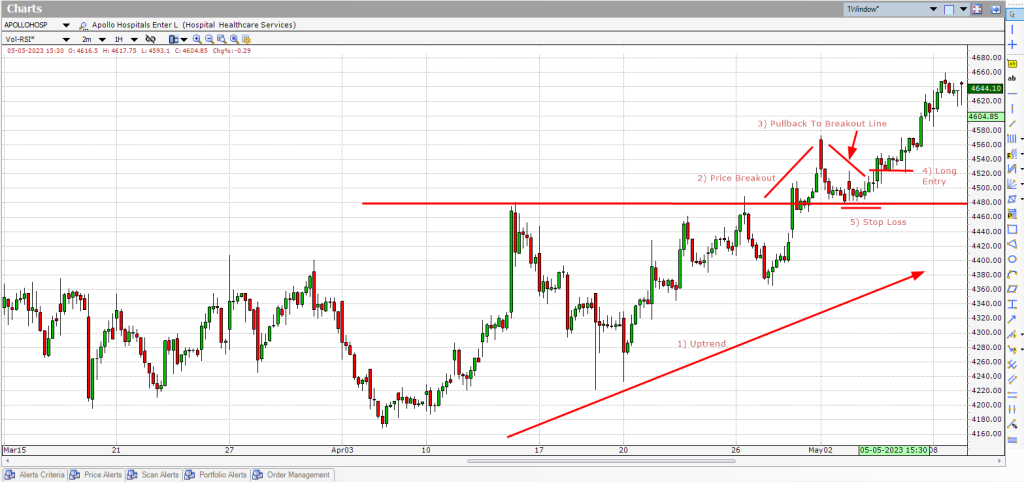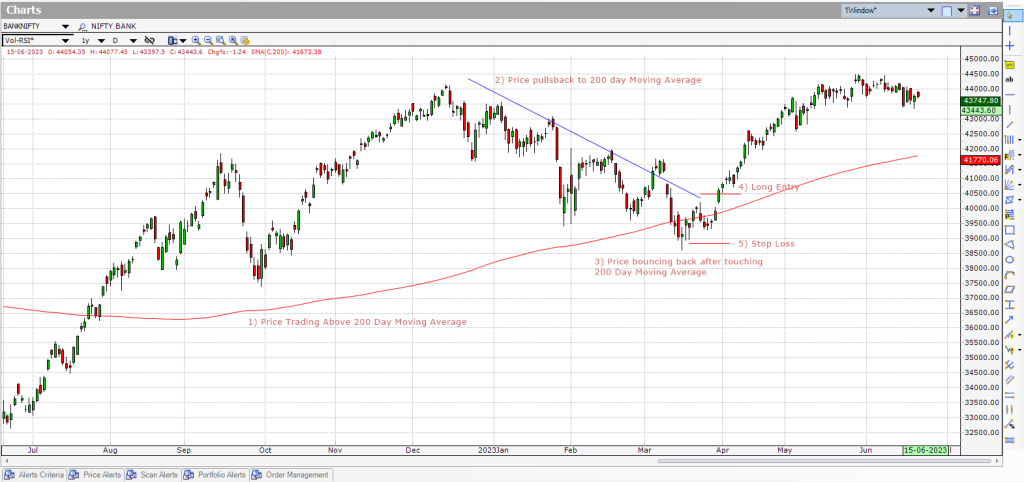In this article, we will explore the different types of pullback trading strategies, provide examples of each, and explain how to trade them. Let’s begin!
What is the pullback trading strategy?
When the price is trending in one direction, such as an uptrend, we want to buy the pullbacks. This means buying the asset when it has temporarily dipped in price, before it resumes its upward trend. By buying the pullbacks, we can get in at a lower price and ride the trend higher.
This is the mantra of almost all successful traders: “Trade with the Trend.” It is the basic rule in stock market trading because when you trade with the trend, you are going with the flow of the majority of market participants. This gives you a better chance of success.
What are the positive aspects of utilizing the Pullback Trading Strategy?
1.Trend Participation: Pullbacks enable trading in the direction of established trends, increasing the chance of profitable trades.
2.Reduced Risk: Entry during pullbacks offers better risk-reward ratios and tighter stop-loss placement, minimizing potential losses.
3.Trend Confirmation: Pullbacks validate trend strength, as strong trends tend to have shallow and brief retracements
4.Avoiding FOMO: By waiting for pullbacks, traders avoid entering trades at the peak of price moves, reducing the fear of missing out (FOMO).
Types of Pullback Trading Strategy available
There are many pullback trading strategies that have been developed by successful traders. In this article, we will focus on three of the most common methods.
- Breakout Pullback Trading Strategy
- Trendline Pullback Trading Strategy
- Moving Average Pullback Trading Strategy
1) Breakout Pullback Trading Strategy
In this strategy, we wait for the price to break out of a consolidation pattern and then pull back to the breakout level. Once the price has pulled back, we enter the trade and ride the uptrend.
How to trade this strategy?
- Identify stocks that have experienced recent breakouts.
- Monitor the breakout line (indicated as the red line in the image).
- When the price retraces to the red line and starts ascending, consider purchasing in this region.
- Keep a stop loss just below point 1.
- Ride the trend after price movement aligns with your position.
- Opt to secure gains at a 1:3 Risk-Reward ratio or adjust by trailing the stop loss until the trend concludes
Example: Apollo Hospital – Hourly Time Frame
2) Trendline Pullback Trading Strategy
In this pullback trading strategy, we first confirm the uptrend by looking for a series of higher highs and higher lows. Once the uptrend is confirmed, we wait for the price to pull back and hit a trendline. This is a line that connects the recent highs of the uptrend. Once the price hits the trendline, we expect it to bounce back and resume the uptrend.
How to trade this strategy?
- Choose stocks exhibiting upward trends.
- Monitor the trend line (represented by the red line in the image above).
- When the price retraces to the trend line and initiates an upward movement, consider initiating a buy position in this vicinity.
- Keep a stop loss just below point 1.
- Capitalize on the trend as the price aligns with your trade direction.
- Opt to secure profits with a 1:3 Risk-Reward ratio or adapt by trailing the stop loss until the trend concludes.
Example – Apollo Tyre – Daily Chart
3) Moving Average Pullback Trading Strategy
In this pullback trading strategy, we will use the moving average indicator to identify potential buying opportunities. We will plot the 200-day simple moving average (SMA) on the daily chart and wait for the price to pull back and touch the 200-day SMA before moving up and resuming its uptrend.
How to trade this strategy?
- Identify stocks trading above the 200-day moving average on the daily chart.
- Monitor the moving average line (indicated as the red line in the image above).
- When the price retraces to the moving average line and initiates an upward trajectory, consider seeking buying opportunities in this region.
- Keep a stop loss just below point 1.
- Capitalize on the trend as the price aligns with your favorable direction.
- Consider securing gains at a 1:3 Risk-Reward ratio or potentially adapt by trailing the stop loss until the trend concludes.
Example – Bank Nifty – Daily Chart
Conclusion
The efficacy of the pullback trading strategy remains effective as long as human involvement persists in the stock market. Rooted in profound human psychology, mastering this approach confers a substantial advantage, enabling traders to navigate diverse market conditions successfully and emerge with profits.
Allocate your resources – time, capital, and effort – into a robust software tool such as Investar. Dedicate time to practicing the pullback trading strategy. As proficiency grows, identifying pullback opportunities on any chart will become a straightforward task.
If you want to see this strategy in more detail, see this video:


